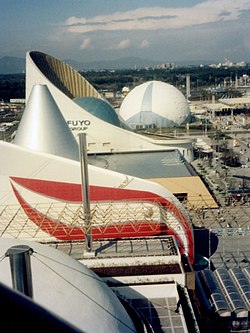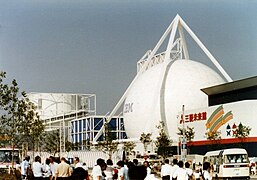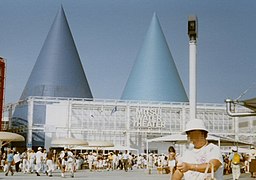Expo 85 (Tsukuba)
| Expo '85 | |
|---|---|
 View of the site |
|
| motto | "Humanity - Housing - Environment and Science / Technology" |
| General | |
| Exhibition space | 102 ha |
| Number of visitors | 20,334,727 |
| BIE recognition | Yes |
| participation | |
| countries | 48 countries, 37 international organizations, 28 private companies / corporations |
| Place of issue | |
| place | Tsukuba |
| calendar | |
| opening | March 17, 1985 |
| closure | September 16, 1985 |
The International Exhibition Tsukuba 1985 ( Japanese 国際 科学 技術 博 覧 会 , Kokusai Kagaku Gijutsu Hakurankai ; abbreviated 科学 万博 Kagaku Bampaku or つ く ば '85 Tsukuba '85 ) was a scientific and technical oriented international exhibition on the western outskirts of the city of Tsukuba in Japan.
background
This world exhibition had a dual purpose:
- on the one hand, Japan wanted to show itself as a high-tech nation,
- On the other hand, the government wanted to draw attention to the science city of Tsukuba, which - in the truest sense of the word - was founded on the green field and was not even noticed in Japan at the time.
The problem was that the science city had neither access to the railway network nor access to a motorway at the time. A shuttle service with buses had been set up from the nearest train station in the south, Ushiku's small station on the Jōban line .
The exhibition
While most foreign exhibitors presented their products conventionally, Japan was well represented with its high-tech companies and two scientific publishers, each with their own pavilions:
- Hitachi
- Toshiba
- Mitsui
- Sumitomo Group
- NTT
- Kodansha
- Mitsubishi
- Kurumakan
- Fujitsu
- TDK
- Matsushita
- Fuyo Group
- Sony
- NEC
- Shūeisha
A portrait-drawing robot could be seen in the Matsushita pavilion. The Hitachi pavilion showed a space animation, whereby the audience stage was rotated by 120 degrees after each performance, so that the exit could take place at the same time as watching the film and entering on the other side. The Sony company attracted attention with its Jumbotron, an outdoor display board measuring 20 × 40 m. Since there were no blue LEDs at the time, the board was equipped with miniature tubes that emitted the three basic colors. Another attraction was the organ-playing robot, which read its piece from the sheet. Speech recognition and translation were demonstrated in the NEC pavilion. - In a large multi-storey greenhouse, plants without soil were raised in trays with artificial irrigation and feeding.
The exhibition concept of the German pavilion was in keeping with a technology fair, but not very entertaining. The German contribution also suffered from the low level of interest shown by German business. Chemistry was not represented at all, and at the end an empty room was filled with furniture.
photos
The Expo site today
As is usual with such exhibitions, there were plans to use the infrastructure invested. The pharmaceutical company Astellas built a large research complex there . The Fujikin company (metallurgy) also has a research laboratory there, but there was still space left. A quarter of the area is now occupied by the "Memorial Park to the Expo" ( 科学 万博 記念 公園 , Kagaku Bampaku Kinen Kōen ).
The “Tsukuba Expo Center” in the middle of the city keeps memories alive on a small area, continues the exhibition idea on a small scale and also has a large planetarium.
Remarks
- ↑ The settlement was at the intersection of three districts and a village and, because of the fact that the population was divided into four, did not appear on any map on a slightly larger scale.
- ↑ The Japanese Auto Industry Exhibition Pavilion.
- ↑ Fuyo is a loose group of companies in the succession of the Yasuda group.
literature
- Thomas Marill: A Visit to the Tsukuba Science Exposition . In: AI Magazine Volume 6 Number 3 (1985), pages 94-100.
Web links
- Expo 1985. Bureau International des Expositions (English). Retrieved March 23, 2017 .
- Tsukuba Expo Center
- Overview of the Expo in German
Coordinates: 36 ° 3 ′ 54 ″ N , 140 ° 4 ′ 33 ″ E




